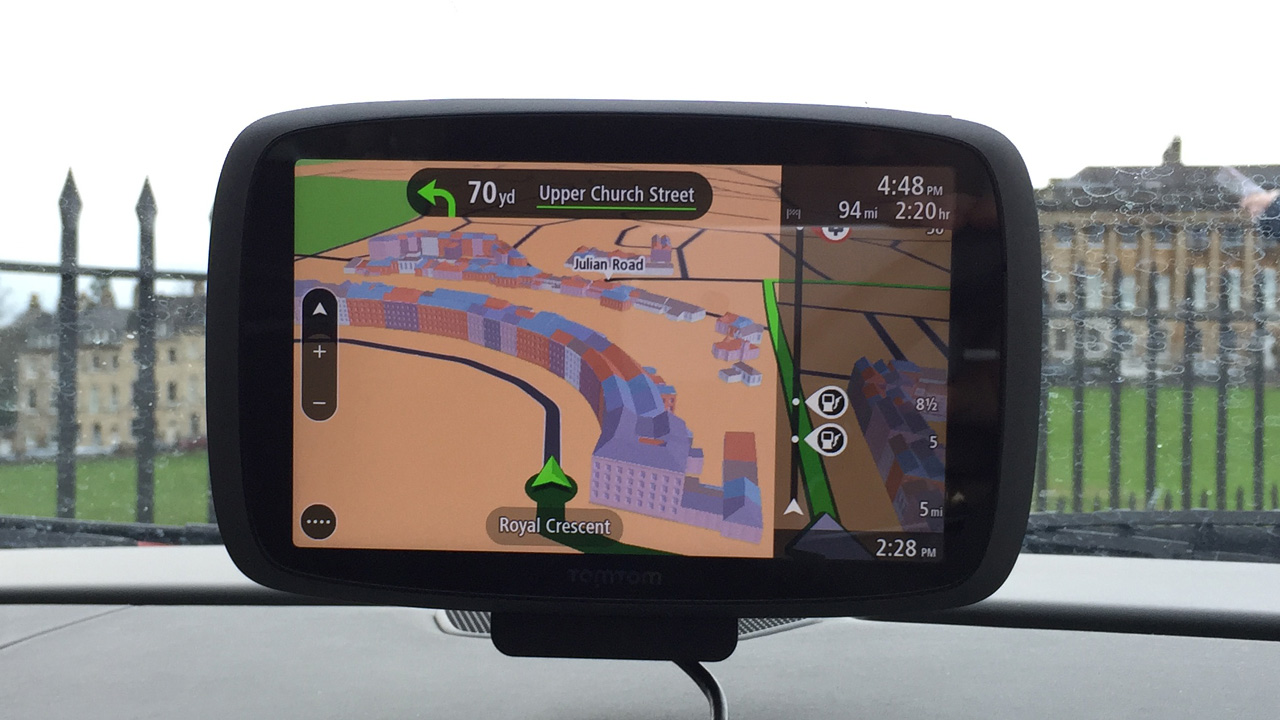TechRadar Verdict
This is a super single-purpose sat nav device and perhaps the best we've tested. You do pay the price for quality, but it's worth it.
Pros
- +
Responsive screen
- +
Super mapping
- +
Awesome interface.
Cons
- -
Slow CPU performance
- -
Silly profile management
- -
Useless voice control.
Why you can trust TechRadar
Make no mistake, the new TomTom Go 6100 is not a cheap navigation device.
At £260 / $370 / around $AU510, it operates very much at the premium end of the sat nav spectrum. But that actually makes life a bit easier for TomTom. This is a device for serious nav users, not a cheap alternative to a smartphone app. If having a proper stand-alone device matters to you, the pricing may not be an impediment.
With a six-inch screen, it's bigger than all but the fattest phablets, too. That makes it more ergonomic on the eyes. But also means it has a more cluttering impact on the inside of your car. This is no tiny clip-on GPS gadget.
In other words, it's a proper tool for dedicated road warriors from one of the best established brands. It's TomTom's latest and great, the finest sat nav it can offer. Let's find out exactly how good it really is.
Features
Visually, the new TomTom Go 6100 is a dead ringer for its Go 6000 progenitor. It likewise shares its basic sartorial characteristics with the Go 5100, but brings a six-inch, 800-by-480 pixel screen to the party where the Go 5100 is a slightly smaller five-inch affair.
For the Go 6100, there's a little less bezel, so if anything the bigger model is slightly more pleasing on the eye. Whatever, it comes as standard with the usual in-car GPS paraphernalia including TomTom's slick magnetically-clasped and suction-mounted Click&Go cradle and a 12v-to-USB power adapter.
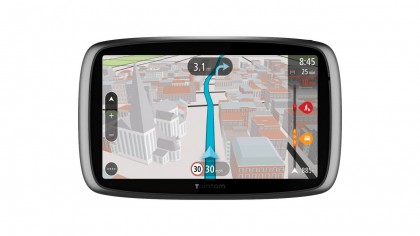
The touchscreen is capacitive (hurrah) and supports pinch, zoom and swipe gestures. There's also full voice control available throughout the interface. The services, maps and other data features are all included and for life.
To that end, the device has an integrated GPRS cellular modem. If that sounds sluggish, it's not there to update or download maps, which would require a beefier pipe. It's for live traffic data and the MyDrive cloud-based feature.
Above and beyond TomTom's general prowess at navigation, it's MyDrive that is perhaps the Go 6100's killer feature. Core functionality includes the ability to send destinations remotely to the Go 6100 from your smartphone, PC, tablet or Mac.
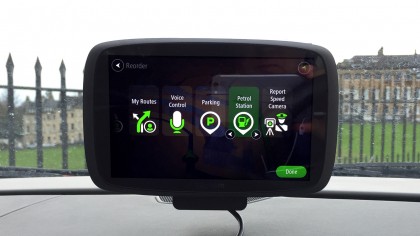
It's similar to Google's Send-to-Car and Send-to-phone features, but runs entirely on TomTom software. The other data-enabled feature is TomTom's handy database of speedcameras. Again, you get free updates forever.
There's no data plan or contract required for any of this, either. You just buy the device and the data services are there for the life of the device. Or, we suppose, the life of TomTom, whichever ends first!
Rounding out the spec is 8GB of internal memory for maps, which you also get for life with free updates. The 6100 offers TomTom's full world maps, but you can't store them all at the same time, so a little juggling may be required in the unlikely event you routinely globe trot in your car. Or you can use the microSD slot to up the local storage.
Finally, the integrated battery allows for around two hours wireless use.
Screen
800 by 480 pixels may not sound like much. But it's enough for a lovely, crisp image at the actual viewing distances typical with a sat nav device.
That said, it's not the most vibrant screen. And it does suffer from a little reflectivity. But it gets the job done. What's more, thanks to the capacitive touch input, it's far more responsive than your usual sat nav, many of which still stick with clunky resistive input screens. Yuck.
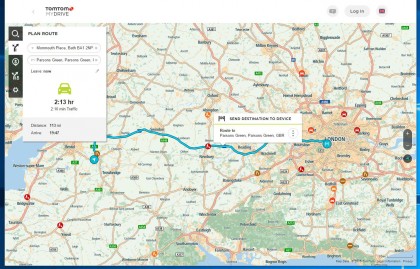
Size-wise, six inches makes for great usability and legibility. But it does also mean the Go 6100 somewhat takes over your dash. Minimal it ain't.
Performance
First up, this is a very robust-feeling device. The build quality is reassuring and the magnetic cradle makes mounting the Go 6100 an absolute breeze, although it does have an occasional tendency to escape the magnetic clasp when you adjust it and you can guarantee it would be airborne in the event of an accident, which is not ideal.
Also worthy of praise is the 12v USB power adapter. It's compact and fits snugly in car power ports. It can be used to power any USB device and it's just a zillion times better than the huge, hideous contraptions some sat nav makers still deliver.
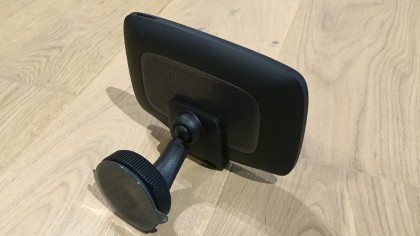
Regards the general interface and sat nav operation, we'll refer you to our review of the TomTom Go 5000. Not a great deal has changed and that's mostly good because it means lovely graphics and maps and impeccable interface logic.
We particularly like the route progress panel on the right of the map during guidance and the way the interface minimises the number of finger punches required to access the most important features. For instance, with just two finger prods you can see all the petrol stations in the local area.
For the record, the voice control feature is completely hopeless, but as we're not huge fans of voice control generally, we're not sure we care.
Generally, then, TomTom has boiled down what's important in a nav, made it slick and easy and and ditched everything else. Brilliant.
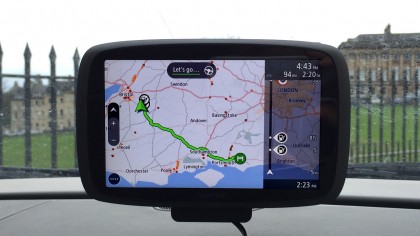
The one downside is sheer compute performance. The CPU and graphics still aren't up to the job of rendering the interface smoothly. It's quite laggy still and that is disappointing.
As for MyDrive, we were sceptical but we shouldn't have been. It's works brilliantly in terms of being able to plan routes on your computer or smartphone and then fire them over the ether to the TomTom.
And it really is instant. So long as the TomTom has a network signal, it picks up sent navigation instructions within a second of you pressing send. It's crazy quick.
You will of course need to have that network signal, which could be a problem depending on where your car lives. But it's not a huge issue as the device will download the data the moment you have a signal.
If there is a downside, it's that smartphone use requires its own app. You can't use Google Maps or Apple maps to send destinations to the TomTom.
The only other downside to MyDrive is that it doesn't support multiple profiles. In fact, you need to fully reset the device and wipe any local history data to change profiles. That is very, very dumb.
We liked
Nearly but not quite everything. The interface looks great and its logic is flawless. The cradle is high quality and easy to use. And the new MyDrive cloud service is awesome.
We disliked
The 6100's CPU and graphics still under perform. That you can't change MyDrive profiles without a full reset is ridiculous, too, and the voice control is hopeless. The magnetic mount is great for ease of use but not great for safety in the event of an accident.
Final verdict
Raw performance and MyDrive profile management aside, this thing simply rocks. If there's a better stand-alone sat nav out there, we've not seen it.
Please put a better CPU inside, TomTom, and then a perfect score would almost certainly ensue.
Technology and cars. Increasingly the twain shall meet. Which is handy, because Jeremy (Twitter) is addicted to both. Long-time tech journalist, former editor of iCar magazine and incumbent car guru for T3 magazine, Jeremy reckons in-car technology is about to go thermonuclear. No, not exploding cars. That would be silly. And dangerous. But rather an explosive period of unprecedented innovation. Enjoy the ride.
